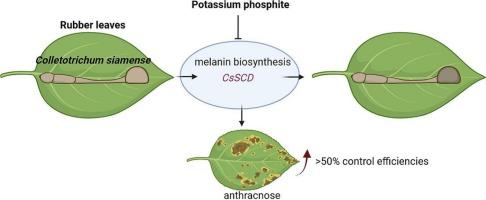Potassium phosphite effectively controls rubber tree anthracnose by inhibiting melanin biosynthesis of Colletotrichum siamense
IF 4
1区 农林科学
Q2 BIOCHEMISTRY & MOLECULAR BIOLOGY
引用次数: 0
Abstract
Anthracnose disease, caused by Colletotrichum siamense, is a major disease affecting rubber trees (Hevea brasiliensis), leading to significant yield losses in tropical regions. Current management strategies primarily rely on a limited selection of fungicides, which are costly due to the persistently low price of natural rubber. This study shows that Potassium phosphite (Phi) markedly suppresses melanin biosynthesis and aborts the formation of melanized appressoria and their primary hyphae in C. siamense. Notably, at the low concentration of 50 mg/L, Phi outperformed tricyclazole in both protective and curative applications for controlling anthracnose on rubber tree leaves. Transcriptomic analysis revealed that Phi and tricyclazole target distinct biological processes, with Phi specifically inhibiting melanin-related pathways and tricyclazole affecting the energy metabolism of C. siamense. Especially, Phi interfered with tyrosine metabolism and catalytic enzyme activities essential for melanin biosynthesis by downregulating several key genes involved in the DHN- and DOPA-melanin pathways. Functional validation confirmed that overexpression of CsSCD partially restored melanin synthesis and appressorial melanization under Phi treatment, suggesting that it may be a molecular target of Phi inhibition. These findings elucidate the molecular mechanisms by which Phi suppresses fungal melanin biosynthesis, offering a cost-effective alternative for managing anthracnose disease in rubber trees.

亚磷酸钾通过抑制炭疽菌黑色素的合成,有效防治橡胶树炭疽病
炭疽病是由炭疽菌(Colletotrichum siamense)引起的,是影响橡胶树(Hevea brasiliensis)的主要疾病,导致热带地区的重大产量损失。目前的管理策略主要依赖于有限的杀菌剂选择,由于天然橡胶的价格持续低迷,这些杀菌剂价格昂贵。本研究表明,亚磷酸钾(Phi)显著抑制了C. siamense黑色素的生物合成,并使黑化附着胞及其初级菌丝的形成中断。值得注意的是,在50 mg/L的低浓度下,Phi在防治橡胶树叶片炭疽病的保护和治疗作用上都优于三环唑。转录组学分析显示,Phi和三环唑针对不同的生物过程,Phi特异性抑制黑色素相关途径,三环唑影响C. siamense的能量代谢。特别是,Phi通过下调参与DHN-和dopa -黑色素通路的几个关键基因,干扰了酪氨酸代谢和黑色素生物合成所必需的催化酶活性。功能验证证实,在Phi处理下,过表达CsSCD可以部分恢复黑色素合成和附着黑色素化,提示CsSCD可能是Phi抑制的分子靶点。这些发现阐明了Phi抑制真菌黑色素生物合成的分子机制,为控制橡胶树炭疽病提供了一种具有成本效益的替代方案。
本文章由计算机程序翻译,如有差异,请以英文原文为准。
求助全文
约1分钟内获得全文
求助全文
来源期刊
CiteScore
7.00
自引率
8.50%
发文量
238
审稿时长
4.2 months
期刊介绍:
Pesticide Biochemistry and Physiology publishes original scientific articles pertaining to the mode of action of plant protection agents such as insecticides, fungicides, herbicides, and similar compounds, including nonlethal pest control agents, biosynthesis of pheromones, hormones, and plant resistance agents. Manuscripts may include a biochemical, physiological, or molecular study for an understanding of comparative toxicology or selective toxicity of both target and nontarget organisms. Particular interest will be given to studies on the molecular biology of pest control, toxicology, and pesticide resistance.
Research Areas Emphasized Include the Biochemistry and Physiology of:
• Comparative toxicity
• Mode of action
• Pathophysiology
• Plant growth regulators
• Resistance
• Other effects of pesticides on both parasites and hosts.

 求助内容:
求助内容: 应助结果提醒方式:
应助结果提醒方式:


